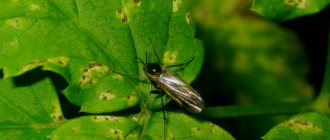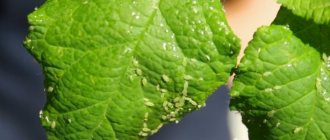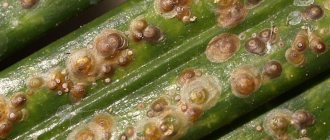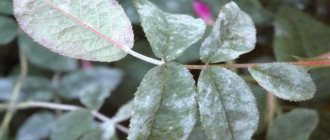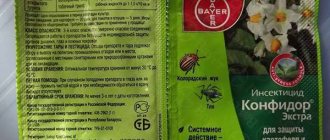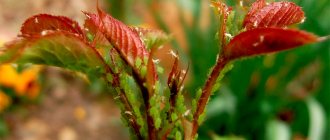What kind of insect is this and why is it dangerous?
An aphid is a white, drop-shaped insect, no more than half a centimeter in length. There are winged and wingless ones.
Winged aphids are capable of moving to other plants . Wingless insects reproduce massively. Aphids pierce leaves and suck out life-giving juices, taking away nutrients from the plant and creating pockets for bacterial infection (you can learn more about what aphids feed on in this material).
Where does it come from and what plants does it affect?
Typically, aphids come indoors on other plants. This could be a bouquet of cut flowers or a purchased infected flower. Sometimes an insect can fly into a room while airing.
To detect aphids, you need to examine the leaves and stem from the inside, where the females lay eggs. The larvae look like small white specks.
White aphids attack dicotyledonous plants; legumes are especially susceptible to attack. White aphids overwinter on pistachio trees .
Favorable conditions for the reproduction of pests are dry soil and high temperatures.
Sources and signs of infection
Often aphids enter the house on the clothes and shoes of residents when they return from the garden or dacha. Another option is with purchased flowers, from where insects can easily move onto any vegetation that is in the room. After purchasing a home flower or shrub, it is recommended to quarantine it, and before that you need to do the following:
- rinse the entire plant;
- disinfect the container;
- change the soil.
Adult flying insects enter the room through windows, vents and doors, and then find indoor flowers and lay eggs on them.
After some time, the owners have to be perplexed, because whole colonies of sucking pests suddenly appear on the leaves.
In the summer, aphids crawl into flower pots placed in the yard, terrace or veranda. In a few days, the colony can cover the entire plant. Ants often become carriers of aphids. They eat honeydew, which is secreted by sucking insects, and then the aphids stick to the body of the ants along with the sweet liquid and end up on other flowers.
It is enough to examine an indoor flower or shrub to understand that it is infested with pests. Aphids are clearly visible, and before they appear, oblong eggs can be seen on the underside of the leaves, especially between the petioles. They are usually located in groups of several. But there are species of aphids in which the young generation is not hatched from eggs, but is born as fully formed insects. If there is no masonry, you need to carefully examine the flower. The following signs should alert you:
- leaf blades, petioles and shoots are covered with traces of a waxy liquid - honeydew;
- the buds do not open, wither and fall off;
- the leaves become stained, curl, turn yellow and fall off.
The sticky liquid secreted by aphids is similar to that produced by other pests, for example, whitefly larvae, scale insects, thrips, and mealybugs. To choose the right treatment method, you need to evaluate the condition of the flower comprehensively, and not based on one symptom, and you will also have to remember what events preceded the disease. For example, before this, the owners of the house went to the country, bought a new plant, had windows open for a long time, etc.
Photo
Take a look at what the insect looks like in the photo:
Damage from activity
Damage from root aphids usually manifests itself as severe "weakness" of the plants. Withered, curled yellow leaves, which resemble signs of nutrient deficiency, appear in various places on the stem, stop growing and fall off. The fruits and flowers on such plants will be small, stunted, and, as a rule, will fall off before reaching their maximum stage of development. Also, as already noted, attacks by root aphids can leave plants vulnerable to various adverse environmental conditions - root rot, mold and disease.
Visible symptoms such as yellowing of leaves often lead to consideration of adding some nutrients to the soil, usually magnesium, but this often fails.
As additional information, it can be noted that root aphids, in addition to indoor, greenhouse and garden perennial plants, affect rice crops, the roots of various trees, including spruce and walnut. White aphids can also cause damage to meadow perennial grasses if their standard hosts are not observed in their distribution area.
How to get rid of pests on indoor flowers?
To combat aphids on indoor plants, both industrial preparations and folk remedies are used.
Chemicals
Fitoverm
A completely safe drug for humans, made from waste products of microorganisms. Fitoverm does not require removing plants from the premises .
It is necessary to dissolve 2 ml of the drug in 200 ml of water at room temperature. Pour the solution into a spray bottle and spray the flower thoroughly.
The biological product has a detrimental effect on pests, but does not accumulate in plant tissues. It acts both contactally when sprayed onto the surface of the body of insects, and when ingested through the intestines while eating treated plants.
After 10-15 hours, aphids lose their ability to feed. To consolidate the result, it is recommended to repeat the procedure after 5-7 days. Fitoverm works more effectively in a warm and dry room .
Aktara
This is a moderately dangerous product for humans; gloves must be worn when using the drug.
To prepare a solution, mix 8 g of the active substance with a liter of liquid. During processing, take the flowers out onto the balcony or street.
Aktar can be used when watering or spraying plants . The drug penetrates the body of insects, causing paralysis and death. After three weeks, you need to treat the flowers again to consolidate the result.
Aktara is addictive; the drug should be alternated with other insecticides.
We invite you to watch a video about how actara is used to combat aphids:
Aktellik
An effective product that begins to work when sprayed. Actellik kills aphids in one application .
Actellik is a non-systemic drug that acts only upon contact with insects and does not penetrate plant tissue. The effect of the product increases in warm conditions and high humidity.
For spraying, Actellik is diluted in a ratio of 2 ml per liter of water. Actellik is toxic and should not be sprayed in the presence of animals or children. It is necessary to wear gloves and a mask, carry out treatment only on the balcony or street and avoid contact with skin.
Homemade remedies
- Red pepper.
Pour 20 g of spices into 250 ml of boiled water. - Leave for 24 hours and boil.
- Cool the contents, strain and add soap.
- Soda and salt.
- For a liter of water you need 1 tablespoon of the product.
- Mix the mixture and spray the plant.
- Ammonia.
- Dissolve 5 ml of ammonia in a liter of water, stir, add soap.
- Spray the flower, leave for half an hour and rinse with water to avoid burns.
- Wood ash . Pour one glass of the ingredient into 5 liters of water, add 25 g of soap and leave the solution for a day.
- Cinnamon . Dilute a spoonful of cinnamon in a liter of water and treat the plant twice a day.
More information about traditional methods of combating aphids can be found here.
The appearance of aphids on plants in the house
More often, it is white aphids that grow on indoor plants, although sometimes insects belonging to other varieties are found. They can settle on the stem, leaves, inflorescences and even on the root.
When heavily infested, the aphids cover the entire underside of the leaf blades and are distributed along the shoot in a dense cover. Diagnosing the lesion is not difficult, since no matter what color the pest is, it is visible to the naked eye. The lifestyle of these small insects is sedentary, and the main source of food is plant sap, which they suck out with their thin proboscis. As a result of depletion, the crop begins to wither, the affected leaves curl, the stem becomes thinner, and the buds fall off without having time to bloom.
Aphids that appear on indoor flowers spread incredibly quickly and in a short period of time can infect absolutely all the plants that are in your home. To prevent this from happening, it is recommended to carry out prevention, which will include:
- regular inspection of each crop - this will identify the parasite when the first individuals appear;
- It is advisable to keep the plants that you have just purchased in quarantine for a week;
- sick and weakened flowers should also be isolated until they are completely recovered;
- Aphids reproduce most intensively on flowers in the presence of favorable conditions for this - dry air and elevated temperatures, and in order to prevent accelerated reproduction of the pest, crops should be grown in a humid environment, periodically spraying them and moving them away from radiators and other artificial heat sources.
Aphids can also grow in the soil of indoor plants. In this case, it is quite difficult to detect the parasite and gardeners learn about its appearance only after the crop begins to wither. But it is quite possible to save flowers, regardless of which part of them the pest was found on.
Pest control on orchids
Aphids are dangerous for orchids; they spread over the entire surface of the plant from the stem to the blooming flowers.
The insect is easy to detect by its white coating . It is necessary to check hidden places - the bases of shoots, buds, the underside of leaves.
Most often, aphids appear on orchids in a dehydrated room. Humidity should be maintained above 60%.
- You should regularly spray the leaves and stem with cool water, avoiding the accumulation of liquid in the flower, and fertilize the plant in a timely manner.
- An infected orchid must be immediately isolated from other indoor flowers, since aphids spread quickly.
- The simplest method of control is to thoroughly wash the flower and remove damaged parts.
The action of a soap solution is antiseptic for the plant and destructive for parasites.- Citrus infusion also helps fight the spread of aphids. To prepare it, you need to mix 100 g of lemon, orange or tangerine peels with a liter of boiling water and leave for three days. For greater effect, you can place the soaked peels on the ground.
- Aphids react poorly to essential oils. Suitable oils for treating orchids include tea tree oil, peppermint oil and neem oil. 30 drops of oil should be dissolved in 500 ml of water and applied to the plant with a sponge.
If these methods do not work, you should use chemicals. For orchids, Aktara, Fitoverm, Neoron, Fosfomit or Actellik are suitable.
You should not carry out more than three treatments with the same drug.
More details about how to fight aphids on orchids can be found in our article.
Features of the pest
Parasites and pests can ruin the appearance of a plant and even cause death. One of the most dangerous parasites for indoor plants is aphids. Both experienced and novice gardeners can damage flowers from this harmful insect.
Important!
Aphids can seriously harm any variety of flowers, because in addition to the fact that they suck the juice from the plant, they are also considered the main carrier of dangerous viruses.
How to fight in the garden?
In the garden, aphids most often attack young shoots and buds . Leaves and stems affected by aphids have a sticky surface because the insects secrete an odorous mass - honeydew, which attracts ants.
- One way to control aphids in the garden is mechanical treatment. It is convenient to use a water hose for this. Using strong pressure, you can get rid of aphids and larvae by thoroughly washing the leaves. You should only remove parasites with your hands while wearing gloves.
- A safe method of killing aphids is the biological route. Ladybugs and lacewings are considered the best fighters among insects; you can buy several of them in a specialized store (read what other insects eat aphids here, and in this article we talked about how ladybugs help fight aphids). You can also attract birds to the garden using a bird feeder. Tits, linnets and sparrows can fight aphids.
- Proper planting helps prevent the appearance of aphids - insects are repelled by onions and garlic, as well as Dalmatian chamomile.
We invite you to watch a video on how to fight aphids in the garden:
Biological agents
Very often, if plants are moved from the room to the balcony, their owners use biological means of protection, attracting beneficial insects, including ladybugs, lacewings, and wasps. They eat aphids without harming plants.
Another way is to place plants next to your house flowers that will help get rid of white aphids on indoor crops. You can grow them yourself, or you can buy seedlings.
ladybugs
Dill attracts beneficial insects with its smell. Ladybugs are very fond of perennial cornflower, a flower that is considered a weed crop in wheat fields. Among garden crops, celery is considered such.
Tansy, dandelion, and cosmos flowers are also loved by ladybugs. Insects will not ignore yarrow, milkweed, fennel, and mint.
Lacewings
These insects may also be attracted to beneficial plants. Several types of mint, especially peppermint and catmint, are needed by lacewings. Cumin and nasturtiums attract winged insects with their strong scent.
General preventive measures
For house plants:
Weak flowers are most susceptible to attack by parasites.- It is necessary to promptly remove dry leaves and yellowed stems.
- New flowers must be quarantined.
- Do not overfeed the plants.
- Be sure to get rid of ants and choose planting sites with diffused light.
- Before planting in a new pot, the flower must be sterilized.
- Twice a week, inspect all plants in the house and regularly rinse them with running water.
For garden flowers:
- Systematically remove weeds.
- During the summer, destroy anthills. This must be done, since ants protect aphids in every possible way and even bring them into the garden themselves (read more about the symbiosis of these insects here).
- In the spring, carry out sanitary pruning of all plants.
- Before buds begin to bloom, spray fruit trees and flower stems with insect repellent.
- Do not overfeed plants with nitrogen.
- Wash plants with a hose.
Mechanical methods of processing plants
If signs of aphid influence are noticed on young foliage (twisting, thickening or brown color), then such plates should be immediately torn off and burned. Among the advantages of this method, one can note the 100% elimination of aphids and the fact that new shoots quickly grow in place of torn leaves,
Important!
White aphids are very dangerous for indoor plants, as they can destroy all the flowers in the house. If you cannot cope with the problem yourself using folk remedies, it is recommended to purchase ready-made chemicals.
Prevention
It is always worth monitoring the appearance of ants on the site. Some of their species bring aphid eggs with them, and then in every possible way support and protect their colony, because they feed on the honeydew secreted by them. For this reason, it is better to carry out the first treatment immediately after detecting ants and immediately from both.
Gardeners and gardeners have many options at hand for killing aphids, but often, without having the necessary information, they choose a completely wrong method, which leads to a worsening of the situation. Therefore, it is still recommended to study the enemy before fighting him.
How to destroy aphids - basic control methods
To remove aphids from useful crops, you should learn to detect the first signs of damage in time, especially when growing indoor plants. This approach is crucial for preserving not only the decorative qualities of plants, but also their life.
You can effectively remove aphids from indoor flowers once and for all using the basic strategy, which is to remove the affected plants from the common space as soon as possible and, if possible, destroy them. This aphid repellent will ensure the preservation of the remaining living flowers.
Trying to feel sorry for the unfortunate plant or waiting for flowers to save something is not recommended. This approach only gives the root aphid a chance to spread to the rest of the plants and eventually you will have to get rid of them all.
If the soil for growing indoor flowers is taken from your own garden, you should start preventive measures from the street. We will tell you about the main preventive measures taking into account these conditions.
Preventive measures to prevent the reproduction of white aphids
- Commercial grade soil, including bagged composts, which may contain live aphids and their eggs, should be avoided at all costs. This is probably the easiest way that aphids spread rapidly in gardens and vegetable gardens across the country. Today it is better to buy soil and compost from a reliable domestic source, for example, from a neighbor who keeps livestock, or to grow your own from regularly mowed weeds.
- It is recommended to actively attract birds, who pick up aphid eggs not only from trees, but also from the ground. Therefore, bird feeders and birdhouses will provide invaluable support.
- Several species of parasitic insects attack aphid eggs, such as sand wasps. Ladybugs are also an excellent cure for aphids, which they find on the surface, but insects buried in the soil are inaccessible to them. Read this article on how to attract beneficial insects to your site.
- Introducing beneficial nematodes into the soil at the first sign of root aphid infestation serves as an excellent preventive procedure. Nematodes will attack a range of soil pests, being completely harmless to earthworms, pets and people. Later we will prepare a separate article about these beneficial helminths.
- Foreign means Azatrol as a preventive treatment on plant roots is a fairly effective remedy, but, unfortunately.
- Neem oil can help stop aphids, but only in cases where they crawl into the external environment.
- Insecticidal soaps should not be used to control soil-borne pests, including white aphids. The insecticidal effect will be expressed to a certain extent, but this requires a sufficiently high concentration of the product, which will become toxic to the roots of the plant.
- Pyrethrum-based sprays can be effective if used early enough in the infestation. Dosages should be used twice as high as standard, and a few hours after treatment, it is recommended to water the plant abundantly. When using such products, repeated treatment will be required every two weeks, since this insecticide has no effect on eggs hidden in the soil, which means that young individuals will soon hatch from them. Such treatments should be repeated until the plant shows signs of improvement in its condition.
- When removing infected plants, you need to be careful not to drop them on the soil and thereby spread the pest to other areas of your garden. You should place the plant to be harvested along with its roots in a bucket and carefully take it out. Removing severely damaged plants, followed by preventive spraying of the growing area, may be the most effective form of control.

